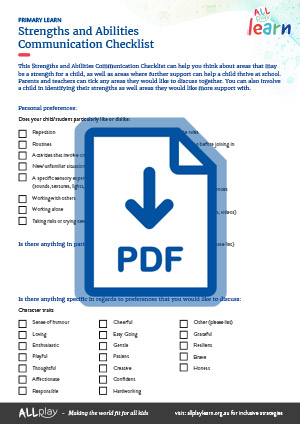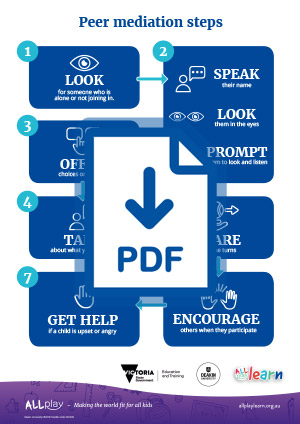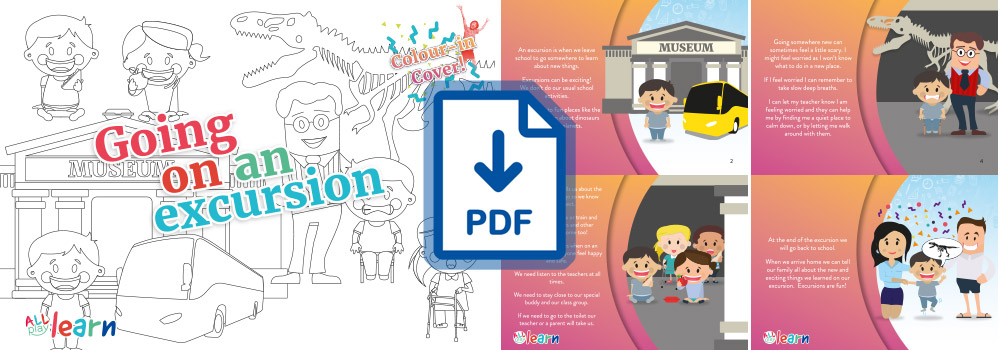
Physical Disability
On this page:

About physical disability
Physical disability is a term used to describe any lifelong condition that affects a person’s ability to move, or to control their body movements. Children with physical disabilities will differ in how much their movement is impacted as there are many different types and causes. This includes paralysis (inability to move one or more limbs), problems with muscle tone, reduced balance, reduced ability to make larger or gross motor movements (e.g. challenges with walking and running), and reduced ability to make smaller or more precise movements (e.g. challenges with writing and doing up shoe laces). Common causes of physical disability include acquired brain injury (e.g. after a stroke), spinal cord injury, cerebral palsy, spina bifida, loss of limbs and muscular dystrophy.
Some children with physical disability will walk independently, while others will use mobility aids (e.g. ankle supports, crutches or wheelchairs). Some children may need support with completing everyday tasks by themselves. They may need extra time to learn and practise new skills.

Strengths
What might be some strengths?
- Children with physical disabilities have different strengths depending on how they might be affected by the condition.
- Some may have typical language and thinking skills and can learn like any other child.
- Some students are strong visual learners and are able to process and maintain visual information.
Where might you provide support?
- Some students with physical disabilities may need support with movement, coordination and balance. Some students might use mobility aids such as a walking frame or a wheelchair.
- Students with physical disabilities may experience chronic or recurring pain. This may affect their behaviour. They may become less motivated to join in.
- Some students with physical disabilities have difficulty with forming and maintaining peer relationships.
- Some students may need support with focus and concentration during activities and discussions in the classroom.
- Some students may have difficulties with writing, drawing, or other craft activities.

Evidence-based strategies
Tailor activities to be as inclusive as possible
Consider adjustments to teaching style
Consider adjustments to communication style
- Plan ahead. Consider preparing equipment or adjustments that encourage full participation of the child before beginning an activity.
- Use alternate methods for assessments. Such as verbal responses instead of written, or extended time for completing tasks.
- Allow more time to learn skills and understand concepts. Some students may need extra time to process and learn new skills in the classroom. It may be helpful to break down key learning concepts and activities into smaller but challenging sequences. Students may need to master basic concepts before moving onto more complex ones.
- Use various methods to teach. Visual aids, such as picture cards, can demonstrate a task sequence or a key learning concept. Consider using material such as captioned videos to teach a skill.
- Provide accessible materials. Provide a range of book formats, such as large print or audio versions, and make sure that all learning resources are within reach.
- Provide access to breaks and rest. Provide breaks and a space for rest for students who fatigue or need time to manage their health needs.
- Use clear and accessible communication methods. For example, if a student has difficulty with verbal communication, use visuals or alternative communication devices.

Best practice tips
Consider whether the physical space needs to be rearranged
Promote independence
Engage the student in decision making
Consider pairing the student with a buddy
Promote self-determination
- Check that pathways are free, wide enough, and neat so that child can move easily and without risk of injury. If a table is used for activities, check that it has plenty of room underneath it for the child to sit comfortably and participate.
- When possible, allow the student to choose what they would like to do (e.g. during recess or on the playground). Encourage adults to give children space to explore or learn independently or with other students. This will help to encourage social interactions with peers.
- In addition to collaboration with parents and health professionals, provide opportunities for the student to participate when making decisions about their learning needs and goals.
- This could be helpful both in and out of the classroom. For example, the student’s buddy can assist with note taking if needed, and can help with social interactions.
- Promote self-determination. Empower and teach children to make simple choices, set goals, be independent, and develop problem-solving abilities. Use technology as needed.

Curriculum considerations
- The arts can encourage students with physical disabilities to creatively express emotions and ideas.
- Consider how you can promote creativity and active participation in activities.
- Consider making adjustments to your teaching style.
- Adapted materials may be needed so that a student can fully participate. For example, thicker pencils and paintbrushes might help with grip, paper can be taped down and placed on slanted surfaces, and scarves, balls and other materials may better engage students with physical disabilities in dance.
- Encourage a culture of respect among students. Consider including videos that highlight the participation and strengths of role models with physical disabilities, such as the videos from our AllPlay Dance Ambassadors.
- More tips and resources regarding inclusive strategies for dance are featured at AllPlay Dance.
- Encourage the use of devices and objects that best support the student’s communication and learning, and that best fits their bodily needs. For example, some students might learn better with pictures cards that are used along with verbal instruction, whilst others might benefit from audiobooks or text-to-speech technology.
- Consider using computer software to help with reading and writing. Discuss with the student's parents and support team about the ways to approach this.
- Encourage active participation in literacy activities. A variety of methods (e.g. reading, drawing, videos) may engage and motivate students.
- Placing various textual and visual material and objects in locations that are easily accessible and visible may promote literacy skills for students with disabilities. Consider having posters on the walls, labels on objects and a variety of story/picture books.
- Students with physical disabilities may benefit from reading storybooks and other written passages multiple times. This could help increase their reading fluency and comprehension.
- Provide positive feedback and correction immediately during learning tasks and activities.
- Consider making adjustments to physical education activities for students who need support with movement, coordination and balance. There are lots of resources and tips provided at AllPlay Footy to help you include students with physical disabilities in group sports such as footy.
- Encourage team work and give the student an active role in sporting activities. This will provide opportunities for the student to participate and give them a sense of belonging and acceptance.
- Encourage a culture of respect among students. Consider including videos that highlight the participation and strengths of role models with physical disabilities.
- Consider the student's strengths and use this to guide physical activities. Some rules during sporting games may need to be changed to encourage full participation. For example, instead of kicking a ball, a student may need to carry the ball instead. Similarly, a delayed defence rule, where students can choose three, five or 10 seconds of delay before a defender can approach them in a game, may be helpful for some students.
- Check that the surface of the sporting area is not too slippery or sticky for the child to move around.
- Consider what accommodations could be made to sporting equipment. For example, lighter balls, bats or racquets may benefit students with physical disabilities. Lower basketball nets may be helpful for students who sit in a wheelchair or use a walking frame.
- Be aware of signs of pain and fatigue. Look for non-verbal signs such as changes to facial expressions, changes in movement, changes in behaviour, and changes in peer interactions.
- Some students may need frequent rest breaks to manage fatigue and pain.
- Consider making adjustments to your teaching style.
- Some students with physical disabilities may need extra time to speak and express themselves. Allow the student to use their preferred communication aid. Some students might use pictures, gestures or technology such as tablets and speech devices. Encourage the child to use technology that best supports their learning, and that best fits their bodily needs.
- Consider teaching other students and staff members to understand and use the child’s communication method. For example, if a child uses pictures and symbols, It might be helpful to encourage the use of a few of these during classroom activities (such as when requesting objects).
- In addition to verbal cues and instruction, you can use visual aids, such as picture cards, to show a key learning concept. Consider using material such as captioned videos.
- You may need to sound out words with the student, and show how to blend these sounds to create phrases and sentences. Some students might need more time and multiple repetitions.
- Encourage group work. Some students with physical disabilities may benefit from activities that allow them to work together with their peers.
- If a student uses adaptive technology to assist with everyday tasks, consider using these in the maths classroom. For example, if a student uses a laptop with an adapted keyboard, include maths exercises that are available in an online format for the student.
- Computer software may help students learn and practise numeracy skills.
- Consider the learning environment to allow safe learning for students with physical disabilities. For example, check that pathways are wide enough for easy accessibility.
- Consider the equipment. For example, check that the tables are at an appropriate height for those that sit on a wheelchair and that items such as microscopes can be easily reached by the student.
- Check that tables have enough space underneath so that students in wheelchairs can sit comfortably. Consider seating position and duration for students who need extra help to support their posture.

Other considerations
First aid
Safety drills
Behaviour
Homework
Excursions
Self-management
Transitions
Other co-occurring conditions
- Talk to the student’s caregivers about ways to manage injury, illness, pain and fatigue early on.
- Build a relationship with other professionals that look after the student (e.g. occupational therapist). That way you will be informed on signs to look for, adjustments that can be made to relieve discomfort, and the best ways to manage injury, illness, pain and fatigue. Frequent check-ins may be needed with some students.
- Some students with physical disabilities may not know how to tell an adult if there is an emergency, or what to do in an emergency or emergency drill. Consider making time to demonstrate and practise.
- Develop and practise emergency evacuation plans that account for the needs of students with physical disabilities, ensuring they are safe and can exit the classroom effectively in case of an emergency.
- Students can monitor their performance if they have a clear understanding of what is expected. Consider talking with students to check their understanding of expectations.
- Refer to the ABC approach for more information on how to reduce challenging behaviour by supporting the child and promoting more helpful behaviour, and our emotions page for more information about supporting a child with managing their emotions.
- Some children with physical disabilities may find completing some homework tasks challenging. Consider the students’ use of technology or assistive devices. For example, some students might have trouble with writing and may benefit from homework that they can complete using their assistive computers/keyboards.
- Work with the students’ parents to develop an effective and consistent homework routine at home. Consider discussing and demonstrating some teaching strategies and reward systems used in the classroom.
- Consider the transportation needs of the student. For example, if using a bus, check that it has ramps and is wide enough to accommodate a wheelchair or other mobility aids.
- Consider the destination and whether it is accessible and safe for the student.
- Some students may need to take frequent breaks during the excursion.
- Discuss with a child’s family or other professionals any additional strategies or equipment (e.g. adapted toilet seat, step ladder, railings) that can be used at school to support the student.
- Students with physical disabilities may benefit from being able to choose when and how they might need extra help. Talk to the student to determine the best approach to help seeking, as 'too much' help may decrease self-esteem and limit the student’s sense of belonging.
- A student with physical disability may benefit from supports when moving across education settings.
- Let students know what will be the same so that they know they already have some of the skills they will need.
- For more information about supporting students with disabilities when transitioning to a primary or secondary school setting access AllPlay Learn's transition page.
- For children transitioning to primary school access AllPlay Learn's Story A school day, and for children transitioning to secondary school access Access AllPlay Learn’s story How to be organised
- Physical disabilities can often co-occur with other developmental delays such as intellectual disability or specific learning disability. They can also co-occur in children who experience deaf and hard of hearing, blind or low vision, and challenges with attention and communication.
- Refer to information about these areas to help support the student.

Relevant resources
Visit our resources page for a range of resources that can help to create inclusive education environments for children with disabilities and developmental challenges. Some particularly relevant resources for children with physical disability include:









